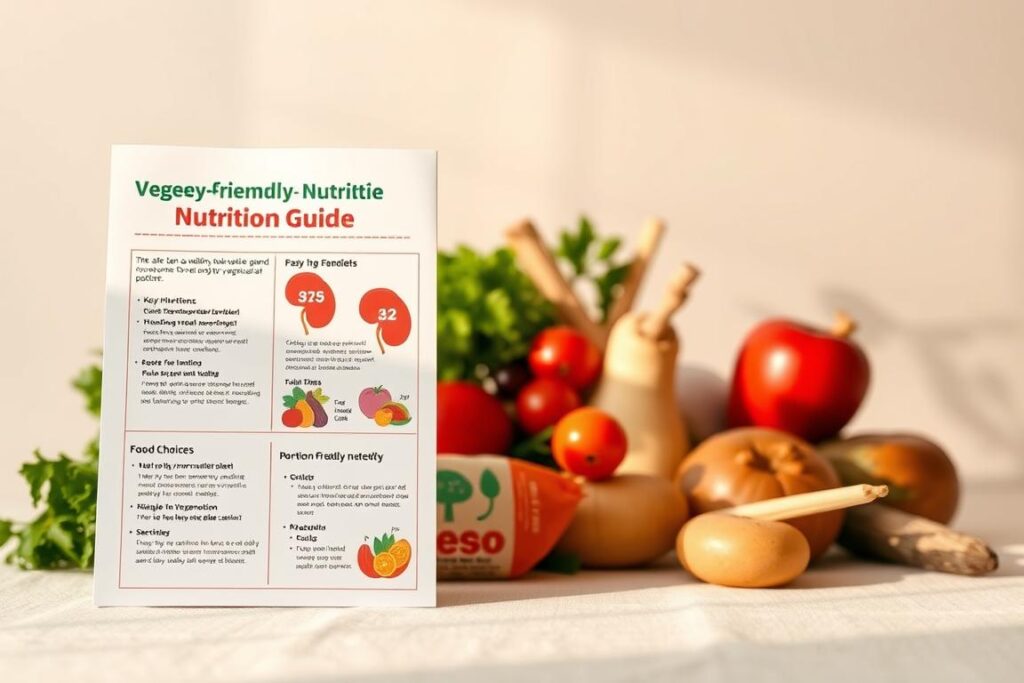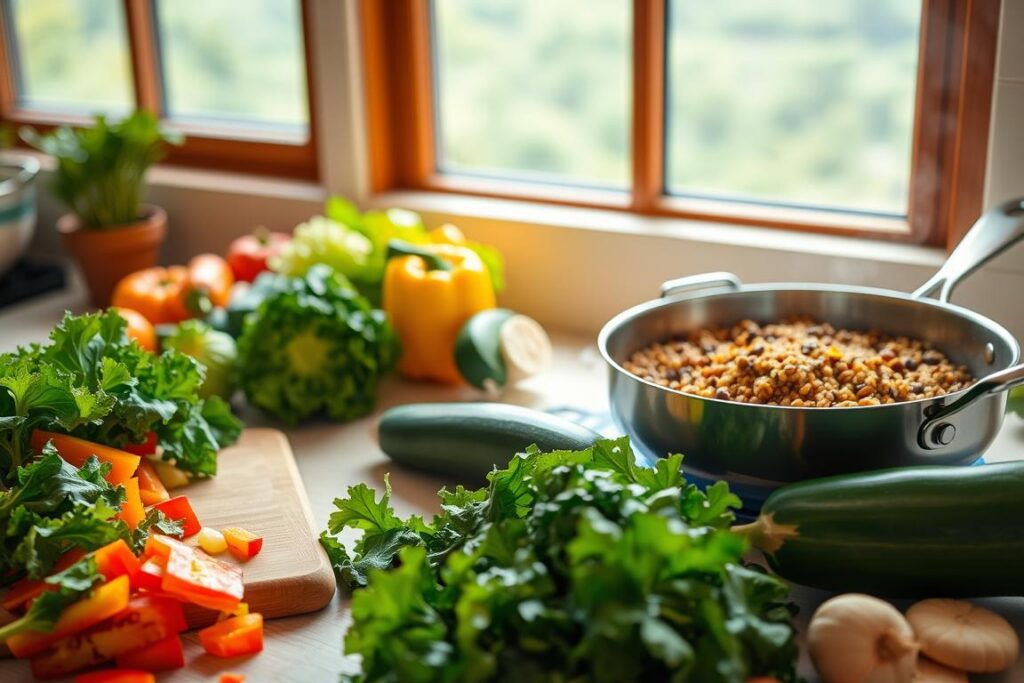Living with chronic kidney disease can be tough, making it hard to find healthy meals. I’ve been there, and I know how hard it is to eat right. But, there’s hope in vegetarian dinner recipes for chronic kidney disease. They offer tasty, healing meals that help you stay well.
It’s not hard to make your diet kidney-friendly without losing flavor. Your diet can help manage your kidney health by giving you the nutrients you need. This guide will show you how to make every meal a chance to heal and enjoy.
Key Takeaways
- Plant-based diets can significantly support kidney health
- Careful nutrient monitoring is key for managing kidney disease
- Vegetarian meals can be both delicious and kidney-friendly
- Controlling portions and choosing ingredients is important
- Nutrition can slow down kidney disease
Understanding Kidney-Friendly Vegetarian Nutrition
Living with chronic kidney disease means you need to plan your diet carefully. This is true for vegetarians looking for plant-based meals that are good for their kidneys. What you eat can really affect your kidney health and how you feel overall.

Key Nutrients to Monitor
When you’re on a kidney-friendly vegetarian diet, you need to keep an eye on certain nutrients:
- Protein: Pick high-quality plant sources like lentils, tofu, and whole grains
- Sodium: Try to stay under 2,300 milligrams a day
- Potassium: Eat it in moderation by choosing the right foods
- Phosphorus: Stay away from foods with added phosphorus
Benefits of Plant-Based Eating
Vegetarian diets low in protein have big benefits for your kidneys. Studies show they can:
- Slow down kidney damage
- Lower inflammation
- Help control blood pressure
- Protect kidney tissue
Common Nutritional Challenges
Vegetarians with kidney disease face special diet challenges. Talking to a registered dietitian can help. They can create a meal plan that fits your needs and keeps your kidneys healthy.
Proper nutrition is key to managing chronic kidney disease through thoughtful, balanced plant-based eating.
For more ideas on low-potassium vegetable recipes, visit Vegetable Recipes for Kidney Patients.
Essential Guidelines for Creating Kidney-Safe Meals

Making kidney disease-friendly dinners needs careful planning and the right food choices. When cooking low-potassium vegetarian dishes, follow some key rules to help your kidneys.
Here are the main guidelines for your meal prep:
- Control portion sizes to manage nutrient intake
- Select ingredients with lower phosphorus content
- Choose vegetables with reduced potassium levels
- Use low-sodium seasonings for flavor
It’s important to know how your body absorbs nutrients. Studies show that 30-60% of phosphorus from beans and nuts is absorbed. But over 90% of phosphorus from processed foods gets into your body. So, picking the right ingredients is key for kidney-friendly vegetarian meals.
The National Kidney Foundation has a tip to lower potassium in veggies:
- Slice vegetables 1/8-inch thick
- Rinse thoroughly
- Soak in warm water for at least two hours
- Use a 10-to-1 water-to-vegetable ratio
It’s also important to keep potassium intake under 2,000 mg daily. Choose fruits like apples, cherries, and pears, which have less potassium and are safer for those with kidney disease.
By following these tips, you can make tasty, healthy vegetarian meals that are good for your kidneys and delicious to eat.
Building a Kidney-Friendly Vegetarian Pantry
Having a well-stocked pantry is key for making low-phosphorus meals that are good for your kidneys. Your kitchen can become a place of healthy vegetarian recipes for dialysis patients. This happens when you pick ingredients that are easy on your kidneys.
Low-Phosphorus Ingredients to Stock
Start by picking the right ingredients for a kidney-friendly pantry. Look for low-phosphorus veggies that are full of nutrients but don’t hurt your kidneys.
- Bell peppers
- Cucumbers
- Carrots
- Onions
- Green beans
Safe Plant Protein Sources
Protein is important, and you can find it in plant-based foods that are good for your kidneys. Here are some top picks for protein in vegetarian recipes for dialysis patients:
| Protein Source | Protein Content | Kidney-Friendliness |
|---|---|---|
| Tofu (firm) | 10g per 1/2 cup | Excellent |
| Lentils | 9g per 1/2 cup | Good |
| Tempeh | 15g per 1/2 cup | Moderate |
Recommended Seasonings and Herbs
Add flavor to your low-phosphorus meals with herbs and spices that are good for your kidneys:
- Fresh herbs: Basil, parsley, thyme
- Garlic powder (low sodium)
- Black pepper
- Turmeric
- Dried oregano
By choosing these ingredients, you’ll make a pantry that helps your kidney health. You’ll also have tasty and healthy meal options.
Vegetarian Dinner Recipes for Chronic Kidney Disease I
Choosing vegetarian dinner recipes for chronic kidney disease needs careful thought. Your meals can greatly affect your kidney health. They can also be tasty and fulfilling.
To make kidney-friendly vegetarian dinners, pick ingredients wisely and control portions. A good renal diet recipe should have:
- Protein: 20%
- Fat: 25%
- Carbohydrates: 50%
- Fiber: 3%
Here are some tasty, kidney-friendly vegetarian dinner ideas that are also nutritious:
- Tofu Stir-Fry with Low-Potassium Vegetables
- Calories: 350
- Protein: 20g
- Carbohydrates: 30g
- Fat: 15g
- Vegetable Pasta Primavera
- Calories: 400
- Protein: 10g
- Carbohydrates: 70g
- Fat: 10g
When making these meals, use low-potassium veggies like bell peppers, cabbage, and green beans. Stay away from high-potassium foods like potatoes, tomatoes, and winter squash. These can harm your kidneys.
Pro tip: Always consult with a registered dietitian to personalize your vegetarian dinner recipes for chronic kidney disease.
By choosing the right ingredients and watching portion sizes, you can enjoy tasty meals. These meals will support your kidney health while keeping your diet vegetarian.
Smart Protein Substitutions for Renal Health
Finding the right protein can be tough for those on a kidney-friendly diet. Your protein choices are key in managing kidney disease and keeping your diet balanced. Plant-based meals are a great way to meet your needs without stressing your kidneys.
Plant-Based Protein Options
Choosing the right proteins is vital for vegetarian diets. Here are some top picks:
- Tofu: Low in sodium and phosphorus
- Tempeh: Rich in protein with manageable mineral content
- Legumes: Provide essential amino acids
- Seitan: Concentrated protein source
Portion Control Guidelines
It’s important to measure your protein intake carefully. Here are some guidelines for kidney-friendly protein:
| Protein Source | Recommended Portion | Protein Content |
|---|---|---|
| Tofu | 1/2 cup | 10 grams |
| Tempeh | 1/4 cup | 8 grams |
| Legumes | 1/3 cup | 6 grams |
Cooking Methods for Proteins
How you cook your proteins matters a lot. Steaming and boiling are better than frying. They help keep your meals low in sodium.
Pro tip: Always consult with a registered dietitian specializing in kidney nutrition to personalize your protein intake strategy.
Managing Mineral Content in Plant-Based Dishes
Creating low-potassium vegetarian dishes needs careful planning and special cooking methods. It’s key for those with chronic kidney disease who want tasty, healthy plant-based meals.
To make low-phosphorus meatless meals, follow these steps:
- Select vegetables with lower mineral content
- Use leaching techniques to reduce potassium levels
- Implement careful portion control
- Choose alternative cooking methods
Leaching is a great way to cut down potassium in veggies. Soaking cut veggies in water before cooking can lower their mineral levels. This method is best for potatoes, sweet potatoes, and other high-potassium foods.
| Vegetable | Potassium Content | Leaching Effectiveness |
|---|---|---|
| Potatoes | High | 90% reduction possible |
| Sweet Potatoes | High | 85% reduction possible |
| Carrots | Medium | 50% reduction possible |
When making low-potassium vegetarian dishes, watch your portion sizes and what you choose. Pick smaller amounts of high-mineral veggies and mix them with low-mineral ones. Talking to a dietitian who knows about kidney health can give you advice tailored to your needs.
Careful meal planning can help you enjoy delicious plant-based meals while supporting your kidney health.
Quick and Easy Kidney-Friendly Dinner Ideas
Managing dinner can be tough for those with chronic kidney disease. These ideas make meal planning easier and support your health. Vegetarian recipes are tasty and good for you.
Creating meals needs smart planning. You want to eat well without spending too much time cooking. These tips help make dinners that are good for your kidneys without taking all day.
15-Minute Meal Solutions
When time is short, these quick vegetarian meals are perfect:
- Quinoa stir-fry with mixed vegetables
- Instant tofu scramble with low-sodium seasoning
- Green salad with roasted chickpeas
- Cauliflower rice with light protein alternatives
One-Pot Dinner Recipes
These recipes are easy to make and clean up:
- Lentil and Vegetable Soup: A hearty option packed with kidney-friendly ingredients
- Mediterranean vegetable stew
- White bean and spinach casserole
Make-Ahead Meal Options
Preparation is key for a kidney-friendly diet. Try these make-ahead ideas:
- Batch cook grains and legumes on weekends
- Prepare freezer-friendly vegetable patties
- Create portion-controlled meal containers
Pro tip: Always consult your renal dietitian to personalize these recommendations for your specific nutritional needs.
Remember, kidney disease-friendly dinners focus on low-sodium, controlled protein, and balanced nutrients. These vegetarian recipes for dialysis patients are flexible, flavorful, and support your health goals.
Seasonal Meal Planning for Kidney Health
Creating renal diet recipes that fit the seasons can make your plant-based meals more exciting. Winter is a great time to make tasty, healthy dishes that are good for your kidneys. Plus, they can be fun and won’t break the bank.
Seasonal meal planning has many benefits for those with chronic kidney disease:
- Maximize fresh, local produce availability
- Reduce grocery expenses
- Introduce variety into your kidney-friendly diet
- Ensure nutrient-rich meal preparation
Your winter meal plan should include foods low in potassium and phosphorus. Seasonal vegetables like carrots, cauliflower, and Brussels sprouts are great for your diet.
Here are some winter tips for making plant-based kidney-friendly meals:
- Purchase seasonal produce in bulk
- Prepare large batch meals for convenience
- Experiment with warming, nutrient-dense recipes
- Use herbs and spices to enhance flavor without sodium
With a good seasonal plan, you can keep your diet healthy and support your kidney health all winter.
Conclusion
Managing chronic kidney disease through diet is key. Vegetarian dinner recipes can help support your kidney health while making meals enjoyable. Almost 10% of the world’s population faces kidney issues, making diet a vital part of staying healthy.
Your diet choices can greatly affect your health. Studies show that plant-based diets can help with metabolic issues, reduce inflammation, and slow kidney decline. By choosing low-protein, nutrient-rich meals, you can create a diet that’s good for your kidneys and provides the nutrients you need.
Every meal is a chance to care for your body. Working with healthcare professionals, watching your nutrient intake, and learning about kidney-friendly diets is important. With planning and creativity, you can make vegetarian cooking a tasty and healthy part of your life, helping your kidneys stay healthy.
For more detailed information on vegetarian diets and kidney disease, check out this Wikipedia guide on vegetarian nutrition.
